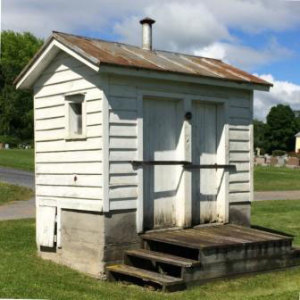The Old Stone Fort Museum Complex presents three centuries of rural New York life in and among eight historic and exhibit buildings on 25 acres in the scenic Schoharie Valley.
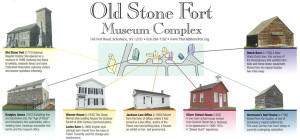
Click to enlarge Map of the Museum Complex
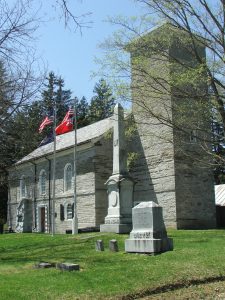
Old Stone Fort, 1772
The Old Stone Fort was built as a High Dutch (German) Reformed Church in 1772. It was the third building erected by the congregation of the Palatine German settlement of Fuchs Dorf (Fox Town). Builders chiseled parishioners’ names into the stones. They include many of the early families of the valley. National Register Historic Site opened as a museum in 1889, featuring two floors of exhibits, research library and store. Knowledgeable interpreters welcome visitors and answer questions informally.
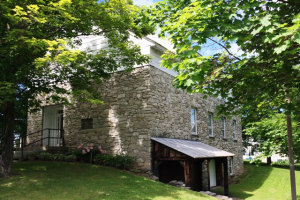
William W. Badgley Museum Annex, 1972
Built by a bequest from Schoharie resident William W. Badgley, the Annex contains two floors of exhibition space and houses the Historical Society’s administrative offices. The first floor exhibits fine art and furniture, and is used for changing exhibits and meetings. The basement houses exhibits on the Age of Wood and transportation, including a 1903 Rambler- the first automobile in the village of Schoharie. Handicap-accessible rest rooms are also located in the basement.

Warner House, circa 1830
This classic Greek Revival style house was originally located where the Badgley Museum now stands. The foundation stones of this building were re-used in the wall along the street in front of the Fort. The building now houses the Scribner Exhibit of 20th Century Communication Technology. The attached carriage shed is not part of the original structure and is used for storage.
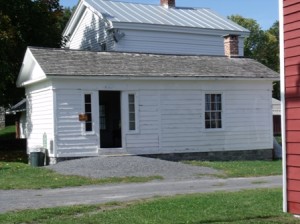
John I. Jackson Law Office, circa 1830
This Greek Revival building was moved from Gilboa where it served as a law office, justice of the peace office and a polling station. When originally built, it probably had a columned portico, later enclosed. It currently houses materials related to Schoharie County law and government including a 1925 voting machine.
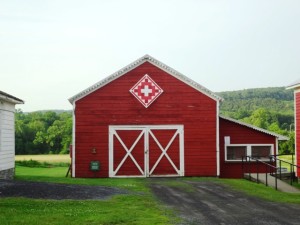
Lacko Barn, circa 1860
This English style horse and carriage barn stood on the flats in the Town of Fulton. It was used by the Vrooman, Schaeffer and Lacko families, among others. When Route 30 was realigned in 1983 and the barn was to be destroyed, the Historical Society moved it to this complex. It is currently used for maintenance and storage. A shed for our events snack stand was added in the late 1990s.
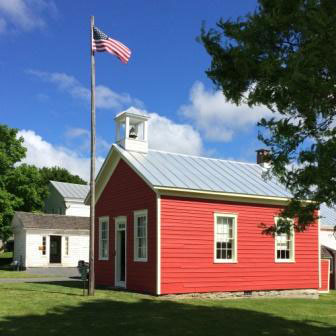
Oliver Schoolhouse, 1863
Donated by Dr. Ward and Dr. Virginia Oliver. Ward Oliver was a former student and teacher at the school. This schoolhouse was moved to our site from its original location between Summit and Charlotteville where it served as a common school for about 80 years. The building is furnished circa 1890-1914 and visiting children are encouraged to sit at the desks and use sample lesson materials provided for great photo opportunities. Behind the schoolhouse is one of its original two outhouses.
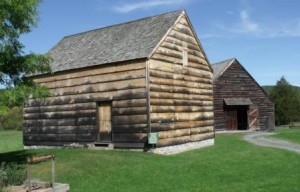
Hartmann’s Dorf House, circa 1786
Palatine Germans settled in seven dorfs (farm villages) in the Schoharie Valley during the early 1700’s. This house was located in or near the site of Hartmann’s Dorf on the Godekeit property between present-day Schoharie and Middleburgh. Although of the early German two-room design, tree-ring dating of a floor beam indicates a date of 1786. This is consistent with a building burned during the 1780 Johnson Raid, and rebuilt to the original plan after the war. Interior door hinges bear the same design as those on the Fort’s front door, undoubtedly made by the same blacksmith. At some point the dwelling was converted to a hop-drying house. The building was moved to this site in 1977 and is partially restored. Interior access is available by special arrangement.
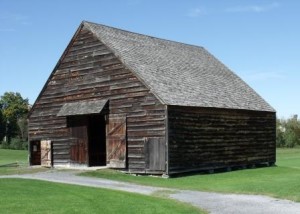
Ingold-Schaeffer New World Dutch Barn, circa 1780
The New World Dutch barn is a type of architecture primarily found in the greater Hudson River Valley, characterized by its nearly square shape, steep roof and gable-end doors. Such barns were used for housing livestock and for grain processing and storage. This barn was once part of the Schaeffer farm south of the Village of Schoharie. According to local histories, the barn narrowly escaped destruction during the Johnson Raid of 1780. The barn was moved to this site by the Historical Society and restored in the early 1990s. Exhibited within are some of the agricultural tools used in Schoharie County over the past 300 years. Please visit Dutch Barn Project to donate to our Dutch Barn restoration project.
Outhouse or Privy, Early 20th Century
This is an unusual above-ground privy. Instead of being built temporarily over a pit in the ground, this permanent structure has small doors in the sides for removing waste for disposal. (Not in use!)
